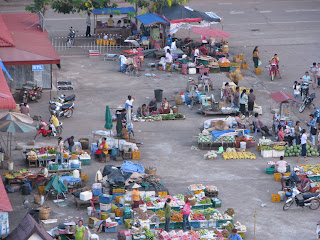 the plane for New Zealand via Melbourne. It was strange to be ending another part of our trip and getting closer to the finish line, but even stranger to be back in a western country. The biggest shock by far were the prices. The US dollar was in the tank and where just a two days ago we were paying $20 a night for a hotel room with all the amenities we could possibly need, now $20 wouldn't even get us a bunk in a hostel dorm room. This reality forced us to get a bit more resourceful, so we finally decided to take advantage of couchsurfing.com - one of the best things to ever happen to independent travelers! Generous people from all walks of life offer to host travelers in return for nothing but a sincere thank you. What a novel idea!
the plane for New Zealand via Melbourne. It was strange to be ending another part of our trip and getting closer to the finish line, but even stranger to be back in a western country. The biggest shock by far were the prices. The US dollar was in the tank and where just a two days ago we were paying $20 a night for a hotel room with all the amenities we could possibly need, now $20 wouldn't even get us a bunk in a hostel dorm room. This reality forced us to get a bit more resourceful, so we finally decided to take advantage of couchsurfing.com - one of the best things to ever happen to independent travelers! Generous people from all walks of life offer to host travelers in return for nothing but a sincere thank you. What a novel idea!Our host, Tony, was a super nice guy and not only had a couch to offer us, but the luxury of a spare room. He gave us some tips for touring downtown Christchurch, helped us sort out our car rental situation and even took us to a local couchsurfing party. A perfect poster boy for all Kiwis, who
 tend to be a very friendly and welcoming lot.
tend to be a very friendly and welcoming lot.Christchurch seems to be a very nice place. It reminds me a bit of a New England college town in that it has a few cultural highlights, a handful of bars and a decent selection of international restaurants. But, for being the South Island's biggest city, it's not a very big city at all. After a couple of days, you might find yourself fondly endeared or totally bored to tears. We probably fell somewhere between those extremes.
Between the head and tail o
 f our loop around the island, we spent about 3 days in Christchurch, which allowed us to take in the architecturally-stunning modern art gallery, visit the Canterbury Museum, which showcases regional history, and hit the weekend market at the Arts Center. We also had plenty of time to check out a couple of matches on the giant chess board in Cathedral Square and wander around the pretty botanical gardens.
f our loop around the island, we spent about 3 days in Christchurch, which allowed us to take in the architecturally-stunning modern art gallery, visit the Canterbury Museum, which showcases regional history, and hit the weekend market at the Arts Center. We also had plenty of time to check out a couple of matches on the giant chess board in Cathedral Square and wander around the pretty botanical gardens.On our last day in tow
 n, we headed out to the Banks Peninsula to check out the former French settlement of Akaroa. We never actually made it though, because we left on an empty take of gas and apparently there are no gas stations between the two cities - at least on the scenic route we took! The empty tank light had been on for about 40 kilometers when we reached a windy dirt road headed across the volcanically formed mountains fr
n, we headed out to the Banks Peninsula to check out the former French settlement of Akaroa. We never actually made it though, because we left on an empty take of gas and apparently there are no gas stations between the two cities - at least on the scenic route we took! The empty tank light had been on for about 40 kilometers when we reached a windy dirt road headed across the volcanically formed mountains fr om the northern coast. It seemed like a pretty risky move (one local we consulted said something along the lines of "gas? out here? good luck - you'll need it"), so we finally decided to turn around and head back toward civilization. We coasted down every hill in neutral and crossed our fingers as we drove on little more than fumes around the curvy coastline and finally through what seemed like an exceedingly long tunnel from Lyttelton back into Christchurch. Amazingly, we made it to a gas station, but it was certainly not the relaxing day we had planned!
om the northern coast. It seemed like a pretty risky move (one local we consulted said something along the lines of "gas? out here? good luck - you'll need it"), so we finally decided to turn around and head back toward civilization. We coasted down every hill in neutral and crossed our fingers as we drove on little more than fumes around the curvy coastline and finally through what seemed like an exceedingly long tunnel from Lyttelton back into Christchurch. Amazingly, we made it to a gas station, but it was certainly not the relaxing day we had planned!
.JPG)
.JPG)
.JPG)
.JPG)
.JPG)
.JPG)

.JPG)

.JPG)



































